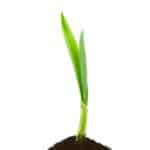There’s nothing quite like heading out into your garden and cutting a bunch of fresh, homegrown mint. However, one thing that you need to know about this wonderful plant is that it is incredibly invasive.
Plant mint directly into your flower beds or in with your other herbs and you’ll soon find that it spreads right across the space.

As it does this, it will steal nutrients from everything else you’ve planted and they won’t be able to thrive and grow into strong, healthy plants.
Once mint has started invading a space, it’s also quite hard to get rid of.
You’ll need to dig up entire flower beds and check the roots of other plants to make sure any suckers haven’t crept in if you want any hope of removing it.
This doesn’t mean that you can’t grow mint, though. In fact, it’s one of the most popular herbs in cooking, so you’ll be able to save quite a bit of money by growing your own.
It also has a few medicinal properties including soothing an upset stomach and relieving indigestion.
If you’d like to grow mint in your garden but you don’t want it to completely take over, your best bet is to grow it in containers.
This stops the mint from being able to rampage through your flower beds and into your lawn.
There are also loads of different types of mint you can grow in containers as well, including:
- Peppermint (Mentha x Piperita)
- Chocolate Mint (Mentha x Piperita f.citrata)
- Spearmint (Mentha spicata)
- Pennyroyal (Mentha pulegium)
- Coriscan Mint (Mentha requienii)
- Watermint (Mentha aquatica)
- Apple Mint (Mentha suaveolens)
- Pineapple Mint (Mentha suaveolens Variegata)
- American Wild Mint (Mentha canadensis)
- Cuban Mint (Mentha x villosa)
Each of these types of mint offers a slightly different flavor and can be used for creating delicious food or drinks (mojito, anyone?!).
However, the one thing that you must remember about each of them, and all other types of mint, is that they are invasive and should be grown in containers to stop them from spreading all over your garden.
Is mint hard to kill?
If you haven’t grown mint in a container, you’ll likely have discovered just how invasive it is.
If it has started spreading through your garden like wildfire, you’ll need to dig it up and dispose of it if you’ve got any hope of restoring your flowerbeds to their former glory.
However, if the mint situation in your garden has really gotten out of control, you may need to resort to killing it altogether.

Even digging up mint can leave behind suckers that can root themselves and, before you know it, you’re back to square one.
But how hard is it to kill mint? There are several ways you can eradicate it completely and, luckily, none of them involve using chemicals that can be harmful to wildlife.
The first, and easiest, way of killing mint is simply by pouring boiling water directly onto the plants.
This won’t only cause the leaves to wilt and die, but will cause real damage to the roots, making it impossible for it to grow back.
If you’ve tried this method but the mint in your garden is particularly persistent, you can try using this homemade mixture:
- 2 cups of salt
- 1tsp dish soap
- 1 gallon of vinegar
Stir this mixture up and pour it directly into the soil, making sure you’re soaking the base of the plant rather than simply hitting the leaves.
This method may take a few applications over a period of time, but it has proven fairly effective in killing mint.
One thing to be aware of when using this method, however, is that it will also kill any other plants that it comes into contact with.
With this in mind, it’s a good idea to dig up any plants and shrubs that you’re trying to save and place them in containers.
Once you’re certain that your mint problem is fixed, feed the soil with loads of organic matter (such as compost or manure) and replant your saved plants.
Where should I plant mint in my garden?
While mint is extremely invasive, it also makes a great addition to any garden or herb beds. It’s also a perennial herb so, once it’s planted, it will come back stronger year after year.
Mint is fairly easy to grow and care for, but there are some things you should do to stop it from getting out of control and to keep it healthy.
First of all, you should always grow mint in a container. The reason for this, as we’ve mentioned above, is to stop it from invading your flower beds and your lawn.
Take a large pot and fill it with good-quality, peat-free, multi-purpose compost. You can also mix in some horticultural grit to help with drainage but, as mint is so hardy, this isn’t a necessary step.
Once your container is filled, simply plant the mint directly into it and place it in an area of your garden that gets a lot of sunlight throughout the day.
Some people like to keep pots of mint by their front or back doors, as it’s easier to pinch some leaves off when you need them without having to trek through your garden to get to it.
It can be tempting to put loads of mint plants into a large container to fill it out, but this is best avoided as too many plants sharing the same space will be fighting for nutrients.
It really won’t take long for one or two mint plants to fill out a large pot, so plant sparingly.
Likewise, try to avoid planting more than one type of mint in each container.
Mixing them together means that, again, the two plants will be fighting each other for nutrients and there is a risk of one becoming much stronger than the other.
Don’t be concerned when your mint plants die back over winter, either. This is normal as they are perennial herbs.
Once winter has passed, you’ll soon see fresh shoots coming up and the leaves can be harvested once the plants are looking full and healthy again.





